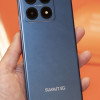BlackBerry 9800 Torch Hands-On
The biggest news from RIM today isn't the BlackBerry 9800 Torch, but the first real release of BlackBerry 6, its newly revised operating system. How did RIM do?
The first thing you'll notice about BB6 is that it is a lot more finger friendly that BB5.x was on the Storm/Storm2. It is vastly re-done, with larger buttons, big icons, and swollen everything. The simple act of making the user interface elements larger and easier to interact with goes a long way to helping the OS become more usable.
The main home screen looks similar to that of the Storm/Storm2, but there's a lot more going on. First you'll notice the notification bar just under the battery, signal, and other indicators. Similar to the way the notification share works on Android, this bar hols all your alerts — new emails, BBMs, text messages, missed calls, etc. Tap it, and it drops down to show you the details about those alerts. If you want to ignore them, just tap again. You want to interact with them, select the message that interests you.
There is also a small app drawer at the bottom that has 4 apps. This is user customizable. Tap it and it expands to show all the apps on the device. Whether this drawer is open or closed, you can swipe it left or right to get at more apps and shortcuts. This borrows heavily from Android and webOS. These two changes alone make the user interface vastly more usable that it was on the Storm/Storm2.
Borrowing another element from Android, if you press and hold an application (or contact) on the home screen, a secondary menu appears that lets you take further actions, such as moving the app icon around, deleting it, opening it, etc.
The one feature that RIM seems most pleased with is the universal search function. Start typing anything (from the home screen) and BB6 automatically starts to scan the device for whatever is typed. If it can't find it, the tool provides links to Yelp, Yellow Pages, Google, etc. Universal Search can be set to scan most anything on the device, including contacts, media, apps, shortcuts and so on. Let's say you search for Bob. It will show you Bob's contact file in the results. Press that and you'll see a range of actions right under your thumb (calling, texting, emailing, etc.).
RIM has refreshed the settings menu (THANK GOD!), and now rather than stark, drab, black-on-white menu lists, there are more icons, descriptions, and items have been lumped under fewer categories, which means there is less scrolling up and down. That's a good thing.
RIM has created its own social networking application. Similar to the way other social networking apps work, it aggregates all the status update content from Facebook, Twitter, RSS, and other sources into a single place on the phone.
The media apps have all been updated, though less significantly than the home screen has. The basic appearance is very similar, but animations are smooth, menus fly by quickly, and everything is more colorful.
In all, BB6 is the most usable operating system developed by Research In Motion. The one problem is that it forges no new ground. Apple, Google, Microsoft and Palm have all tread this ground already. While it is great that RIM has made the OS better all around, it really only catches up to the competition (just barely), rather than surpassing it. RIM will need to stay on its toes and see what it can do to adapt as its competitors do in the coming years.















 Hands On with the Motorola edge+ (2022)
Hands On with the Motorola edge+ (2022)
 Qualcomm vs. Bullitt: Satellite Connectivity Comparison and Hands On
Qualcomm vs. Bullitt: Satellite Connectivity Comparison and Hands On
 iPhone 15 Series Goes All-In on USB-C and Dynamic Island
iPhone 15 Series Goes All-In on USB-C and Dynamic Island
 Hands On with the HMD Fusion and its Smart Outfits
Hands On with the HMD Fusion and its Smart Outfits
 Hands On with the Boost Summit 5G
Hands On with the Boost Summit 5G

